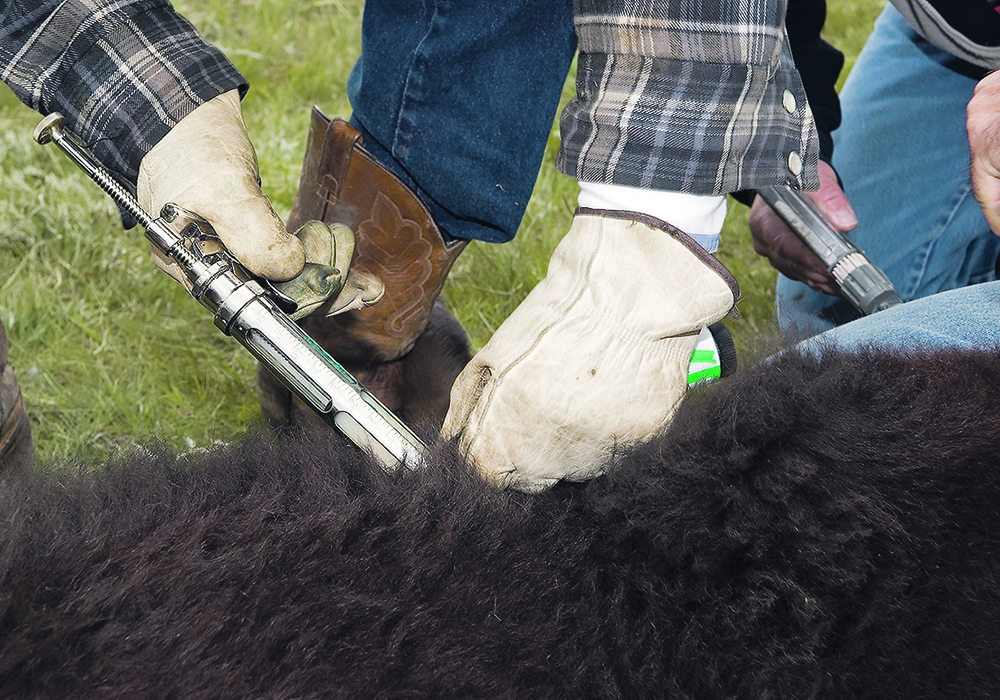A few weeks ago, I wrote an article about a potential infectious bovine rhinotracheitis virus abortion outbreak that a fellow veterinarian was dealing with in his practice.
In that article, I emphasized the importance of including a viral vaccine as one of the core vaccination practices in your herd. These viral vaccines often contain a combination of four viruses: infectious bovine rhinotracheitis virus (IBR), bovine viral diarrhea (BVD), parainfluenza 3 virus (PI3), and bovine respiratory syncytial virus (BRSV).
In many cases, the BVD part of the vaccine contains both Type 1virus and Type 2 virus BVD, which broadens the protection to include the wide number of strains of BVD viruses that are out there.
Read Also

Trump’s tariffs take their toll on U.S. producers
U.S. farmers say Trump’s tariffs have been devastating for growers in that country.
There are both killed and modified live versions of these vaccines available from veterinary pharmaceutical companies and they also have a variety of vaccine lines that may add other antigens to this mix to allow you to vaccinate animals against diseases such as leptospirosis or campylobacter and still only give one vaccine.
My preference is to use a modified live viral vaccine pre-breeding whenever possible. With diseases such as IBR and BVD, we are using the vaccine to provide immunity for the fetus from these important causes of abortion, as well as protecting the cows from these viruses.
Some vaccines will have “FP” on their label, which refers to a fetal protection claim. This means that the companies have performed experiments proving that the BVD portion of their vaccine will protect the fetus against the possibility of abortion and persistent infections that can occur if the fetus is exposed to BVD virus during gestation.
Modified live vaccines give slightly higher antibody levels and in general provide the optimal fetal protection and perhaps more robust immunity than the killed vaccines, which is my main reason for preferring them.
However, the killed vaccines are still effective and if you can’t make a modified live pre-breeding vaccine work in your system, you should definitely consider the killed vaccines. Your veterinarian can help you make the right choice for your herd.
There are two important precautions that are usually listed on modified live vaccine labels that are important to remember. The first is that the vaccines can’t be used in pregnant cows because the modified live IBR virus might cause abortion.
Several vaccines have an exception to this rule, which allows them to be used in pregnant cows, but only if the cow has been vaccinated in the past 12 months with the same brand of vaccine. In some cases, the label may state that they should have received two doses of the vaccine as a non-pregnant animal (after six months of age) before being given the vaccine as a pregnant animal.
These are obviously important label instructions to adhere to and you have to be diligent with your record keeping to make sure that you don’t make a mistake if you are going to be using these vaccines in pregnant animals.
The second precaution that is often listed is that when using these vaccines as a pre-breeding vaccine, it should be given at least 30 days pre-breeding. The modified live IBR component of these vaccines can potentially have negative effects on the ovaries of cows and can temporarily damage the corpus luteum structures on the ovary. The degree of the impact on the next heat cycle is probably dependent on the timing of when the vaccine is given during the estrous cycle.
Several studies have shown that vaccination of animals that haven’t been vaccinated before (naïve animals) within a few weeks of breeding can have diminished reproductive performance. This effect is not nearly as obvious in previously vaccinated animals, but I would still be cautious and try to observe the 30-day window prior to breeding.
A management practice that has been gaining in popularity over the last 20 years is the use of estrus synchronization and the use of artificial insemination, particularly in heifers.
This second precaution of giving the modified live vaccine at least 30 days before breeding becomes even more important if you are using an estrous synchronization and artificial insemination program in your heifers.
It may be tempting to administer the vaccinations at the same time as heifers are being handled for synchronization, but this can have major detrimental consequences on the success of your artificial insemination success if you give naïve animals the vaccine within that 30-day window.
Work with your veterinarian to develop a vaccination program that gives you the optimal means of protecting the cow and her fetus from these diseases, but that also reduces any risk of negative consequences on fertility. If you are considering using estrus synchronization and artificial insemination programs, you may want to consult with your veterinarian to make sure the vaccines are given well before those programs are initiated, which may require some advanced planning.
Make sure you read the label of all the vaccines you use and administer them in the appropriate manner.
Finally, keep good records of your vaccine use. Write down the brands of vaccine you use, who they were given to and the date of administration. You might even want to record lot numbers. This will ensure that you are far less likely to make an error when potentially administering modified live vaccines to your cattle.
John Campbell is a professor in the department of Large Animal Clinical Sciences at the University of Saskatchewan’s Western College of Veterinary Medicine.















